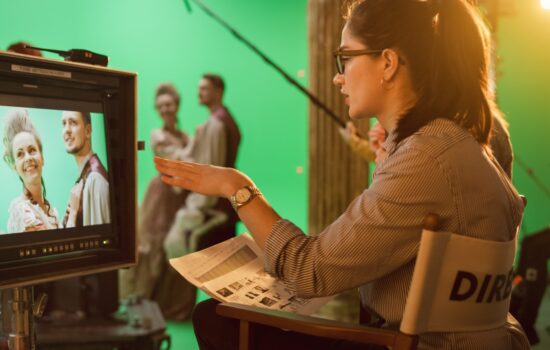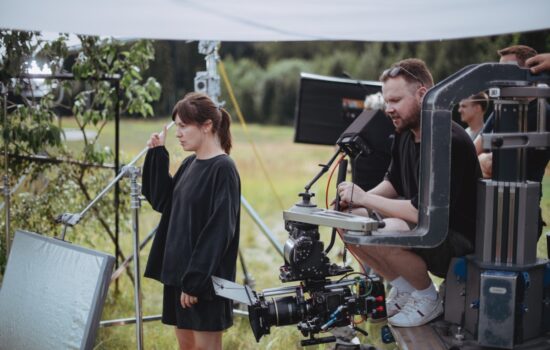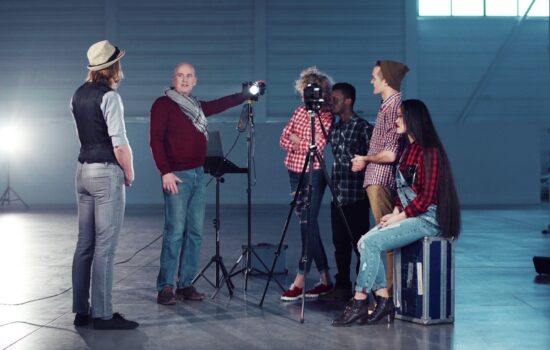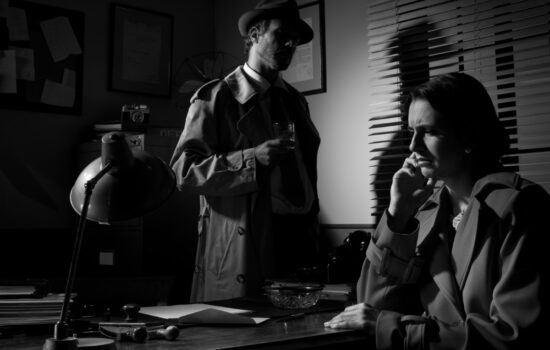Set Decorator
Career Overview
Set Decorators are in charge of populating sets with character and world-specific items on television series, feature films, commercials or short projects. Their remit is vast and includes light fixtures, furniture, floor coverings, personal items and even dust bunnies.
Alternate Titles
Set Decoration
Avg. Salary
$104,0001

How To Become a Set Decorator
People also ask
Career Description
Gigi Barbes, Set Decorator on Sorry For Your Loss, FX’s Better Things and NBC’s A.P. Bio explains her typical workflow on a network television show: “What I’m given as a Set Decorator are sets put together by the Production Designer in concert with the Creator, Showrunner and Producers.
“They’ll have agreed on a look, whether it be on location or a set built on a stage. They might have already chosen wallpaper or other smaller touches but I’m given walls and windows to put everything in, as if you moved into a house with nothing. I put in everything from light switches to light fixtures to rugs on the prepped floors. I choose drapery and furniture and dust bunnies in the corners of the room.
“It’s everything; you might be decorating for a new house look, or something super sterile, or it might be a laboratory, or you might be going as far as creating a space for a hoarder. The range is as endless as story.”
Story is key to a Set Decorator and Barbes values it as the very core of her craft: “I’m an integral part of the storytelling experience. For example, let’s say something dramatic, traumatic even, happened to a character and they decided to stop living their life in 1962.
“Perhaps they stopped redecorating entirely and left their house essentially untouched since then, like the apartment in A.P. Bio. These are the kinds of storylines you need to reflect in your work as a Set Decorator.”
Just as storylines are endless, so too are the periods in which a Set Decorator works, and Barbes gives us some insight into those nuances: “It is nice to do contemporary things because, with the tight timeframes in TV, it’s quicker and easier and everything is accessible at the countless prop houses we have in Los Angeles.
“At the same time, it’s fun to search for period things, whether it be something from hundreds of years past right up to even a decade ago. That’s always more interesting and it helps everyone else — Actors, Director, Cinematographer, Armorer, Set Dresser — to understand where we are in the story. It places everyone in a very specific way and they feel they’re in the right place.”
As for the team and hierarchy in the Set Decorating Department, as Set Decorator, Barbes is the department head. She is in charge of set decoration and collaborates with the Production Designer.
She explains further: “It’s the Producer, ultimately, who hires me but half the time it’s the Production Designer who brings me in with the blessing of the Producer. The rest of the time I’m hired by the Producer with the explicit hope that I forge a solid collaboration with the Production Designer.”
Barbes goes on to shed some light on the Set Decorator/Production Designer relationship: “The Production Designer comes up with the whole ‘look’ of the production, in the old sense of the term. In old Hollywood, the Production Designer would keep charge of the ‘look’ of the architecture and the set palette, etc.
“That way, the Costume Designer/Assistant Costume Designer and the Set Decorator could lock into that ‘look’ and be working on the same story. These days, the Set Decorator and the Production Designer tend to work more in collaboration and that tight relationship means that the story comes naturally to our work.”
Practically speaking, Barbes has a team of people who work with her: “I have a Leadman who is in charge of keeping the billing together, and organizing drops and labor schedules. They also take charge of the Swing Gang — that’s the muscle that picks up all our stuff.
“I also have a team of Buyers, and the size of that group varies depending on the production. I tend to have around three or four, but if you’re doing a big Marvel film, you’ll have huge teams of ‘foot soldier’ Buyers to go out and source things for you.”
These days, as a department head, Barbes doesn’t tend to go out to the prop houses anymore. “On smaller projects, I might go out, but I do miss it. I’d still love to be going out to the houses! Nowadays, my job breaks down into thirds. One third is all meetings; I meet with the Showrunners, Writers, and Directors for concept meetings, production meetings, and development meetings.
“After those, the next third is giving lists of items to my Buyers and they go out and shop. Once they come back, the final third is me choosing from those things, taking stock and seeing what else is missing or what we can craft together.”
Barbes points to the depth of collaboration and inter-departmental teamwork: “There’s the Prop Master, the Special Effects person… There’s even the Construction Department, and they are married to Production Design and the Art Director side of things.
“I do liaise a little with the Construction Department — on bigger budget projects, if they have the time, money and labor, I can ask them to craft some specific furniture, but it’s flexible depending on the scope of the production.”
The schedule is very demanding, Barbes says: “On a half-hour show, I have to put everything together in about five days. It depends how early they give us the scripts but, either way, it’s fast! Plus, while you’re shooting the current episode, you’re already prepping the next two eps so your work is always overlapping. Honestly, it’s constant.”
Not only that, but Barbes’ days are very long: “We work twelve hours a day, sometimes sixteen, but rarely can you switch your brain off. There’s never time to stop shopping or looking for things — when I’m decorating on a show, I live very in the moment so anything I see might be part of a character’s story, something I could bring to set. I have to say, though, it’s a lot of fun!”
In terms of inspiration, Barbes says that she always stays open: “I travel, I read, I have a lifetime of watching television and movies. I also love observing people on the street wherever I am in the world. I do a lot of sports on a daily basis and I use that real-world experience to inform the characters I’m working on, on any given show.
“One of our recent characters was a surfer and I could bring things in from my own experience in the waves. When it comes down to it, I read the script and the characters that someone has taken the time to craft. Then, from my own experience, I deduce the character’s look from that.”
What does a Set Decorator do?
A Set Decorator realizes the vision of the Director, Production Designer, and Art Director by decorating all background needs for a scene such as the walls, floors, and furniture.
Salary
The average annual salary for Set Decorators is approximately $104,000.
Set Decorators work in a freelance capacity and Barbes says that earnings can vary wildly depending both on how much you work over the course of a year, and where you are in terms of career maturity: “It all depends on whether you are early in your career or whether you are further down the line,” Barbes says.
“Add to the mix the frequency of your jobs and the working budget of each production (union or non-union) and your annual salary can range anywhere between $50,000 at the lowest end and $200,000+ at the higher ends. If you’re working on the biggest, Marvel-style studio blockbusters, obviously you can expect much grander sums of money!”
How much does a Movie Set Decorator make?
According to Glassdoor, the average annual salary for a Set Decorator is just under $45,000. Set Decorators can achieve union status, though, which can result in a higher rate for the films they work on. Other factors such as their overall experience and the number of gigs they are hired for in a given year can affect their annual salary as well.
Hey, what do you think about trying our new Film Career HelperFilm Career Helper really quick? It’s totally free and could help get your career moving fast! Give it a try. It’s totally free and you have nothing to lose.
Career Outlook
Barbes explains that each job is different, but creative work is always demanding and constant: “Everything you experience in life is valid inspiration for the sets we create. The environment you walk through, how it makes you feel, that is always registering in your mind and lending itself to future sets.”
Barbes goes on to describe her conventional work structure: “On paper, a ‘normal’ week in TV is early morning starts, twelve hours a day, five days a week. I often work beyond the twelve hours to keep on top of organization, but each Decorator has their own rhythm.
“We are also on-call after hours which means we have to keep ourselves available to answer questions via email and text and answer calls when we’re awake. I do try to unplug in the evenings to allow me to focus on my personal life. I will say that weekend work is rare, but it is sometimes required depending on particular shooting schedules.”
As an experienced Set Decorator, Barbes maintains that ensuring any semblance of a work/life balance takes time and practice: “Actually, it requires discipline, and balance is only realistic with proper planning. My days are much happier and easier when I work out before the day begins, take time for lunch, and catch up with my life and friends at the end of the days and over the weekends.
“Obviously, these plans are often derailed (!), and catching up with life might have to happen during each hiatus and after the project has wrapped. That’s just life, so don’t be hard on yourself.”
Career Path
Barbes describes her journey to Set Decoration as both accidental and deliberate: “Growing up, by habit, I would always be rearranging everything I had in one small bedroom into fifty-two different looks and configurations, every week trying something new.
“I went to college with the idea that I would write and direct but ended up art directing everybody’s student films because I had had my fill of watching people filming a white, dorm-room wall! I would offer my artistic services and people kept taking me up on it — I was just trying to bring some aesthetic variety to other people’s work.”
Once you become a Set Decorator, you’re head of the department so Barbes explains her next steps: “At this point, it’s about my professional choices and finding the best stories on which I want to focus my energy. Art Direction and Production Design would be a totally different path — there are skill sets that cross over like Photoshop or SketchUp and vector work, but I’m focused on the interior design aspects for now.”
“The Art Department and the Set Decoration Department are two different paths”, explains Barbes. “Everybody has a different origin story for their career but, in my experience, I see most people starting as a PA in the Art Department. If you’re looking seriously for a career as a Set Decorator, try and find an entry-level PA gig and begin talking to the department heads to get your name on their books.”
Barbes highly recommends creating a strong portfolio of your work in the arts, and she lays out the possible range of that work: “It can be architectural, film-related, photography, wardrobe styling, interior designing, digital, print, painting, drawing… Really, it’s about including anything to show what you are capable of doing.” Barbes also mentions that Facebook can be a very useful resource in terms of reaching out to friends and acquaintances who might be able to guide you.
“The guilds and union are also great places to connect with professionals who might know of work opportunities. Moreover, these are places rich with potential mentors so take the time to attend the orientation meetings and see who is around.”
- Practice planning. Planning and loving the story you are working to tell will help you get through the long hours once you come to work.
- Get an IMDBPro subscription and contact working Set Decorators. Ask if you can come in and apprentice for them. Obviously, ensure you have a strong portfolio to show them!
Experience & Skills
Barbes admits that she still doesn’t have a reel: “It’s bad, I know, but my whole career has been word of mouth. I will say that is not typical — yes, word of mouth is extremely important once you’re in, but I would urge anyone to build up a portfolio and a reel before stepping into the industry.
“I hire people whose work I find impressive and people who can actually show me what they’ve done. I know it can feel a bit ‘cart before the horse’ building a reel without much experience but a personal website, an Instagram account, anything that shows your taste and aesthetic always helps.”
Barbes digs down into what you need to make a success of set decorating: “It’s a lot of work so it’s something you really have to love. Sure, there’s making the union and all those professional milestones, but the reality is that you’re an artist of the world so you have to be creatively connected and present.
“As you go about your daily life, observe consciously and take notes. With set decorating, the only way to practice the craft with any longevity is to love the art so any experience or skill that fosters that love is worth nourishing.”
Barbes herself is upbeat, yet relaxed and it does take a combination of people skills (for the management side of a Set Decorator’s job) and a cool head under pressure (for the daily exigencies of time on productions).
Barbes adds: “Whatever your specific personality, make sure you get back to your life outside of work at the end of the day and week. That’s crucial, because art is a reflection of the real world. And observe your world by being present and making time for yourself. It will inspire the creative connection within yourself and each character you create.”
What is the difference between a Set Decorator and Set Dresser?
The Set Decorator oversees their staff of Set Dressers and assigns to each of them the sets that they will need to decorate for the needs of the film.
Education & Training
Barbes explains that a lot of people come to Set Decoration the way she did: through apprenticeships. She adds, however, that people do go to school with Set Decoration in mind: “I had a person apply to help me recently and they went to FIDM in Downtown Los Angeles. That’s a place well worth checking out.
“Of course, the major film schools will cover the more ambitious aspects such as Cinematography and Art Design — in the schooling sense, Set Decoration would be a branch of the Art Design module. I also see lots of people coming through interior design schools, too.”
For LA-based readers, Santa Monica College offers a great course in Interior Architectural Design with a specific gearing towards working in film and television. Check your local college to see if they offer something similar with a motion picture focus.
Barbes says that one of her favorite Decorators studied a Masters in Anthropology; in this way, there are plenty of related academic pursuits that can be perfectly informative to a career in Set Decoration:
“Think about it — a Masters in Anthropology, if you’re working on something like Indiana Jones, it’s another investigative tool that you have in your belt. You just have to keep on your toes when you’re reading and writing and studying.”
Additional Resources
The Union for Set Decorators is the Affiliated Local Craftspersons Local 44. Barbes says they set their rate minimums and provide healthcare and legal advice.
To join the union, as with many of the unions in the motion picture industry, you will need to have accumulated thirty ‘permitted’ workdays before you’re entitled to membership. Attend orientation meetings at the union and network with people to find Set Decorators willing to bring you in on permit.
FAQ
What is the single biggest suggestion you would give to someone wanting to get into this career?
“Start now.”
What’s the #1 mistake people make when trying to get into this career?
“Not asking enough questions.”
If you could describe in one word what makes you successful, what would it be?
“Present.”
Sources

Gigi Barbes
Gigi Barbes started as a Production Assistant on Men In Black: The Series before graduating to Art Coordinator on that show. She then art directed Todd Berger’s It’s A Disaster before becoming a Set Decorator, working on network shows including Mike O’Brien’s A.P. Bio on NBC, FX’s Better Things and Sorry For Your Loss on Facebook Watch.
Learn more about Barbes’ career in set decoration via Bustle and AV Club.
References
- 1THR Staff. "Hollywood Salaries Revealed, From Movie Stars to Agents (and Even Their Assistants)". The Hollywood Reporter. published: October 2, 2014. retrieved on: April 13, 2020



















